- home
- BAKERECIPES
BakeRecipes
Bringing real baking into your home with deliciously simple recipes.
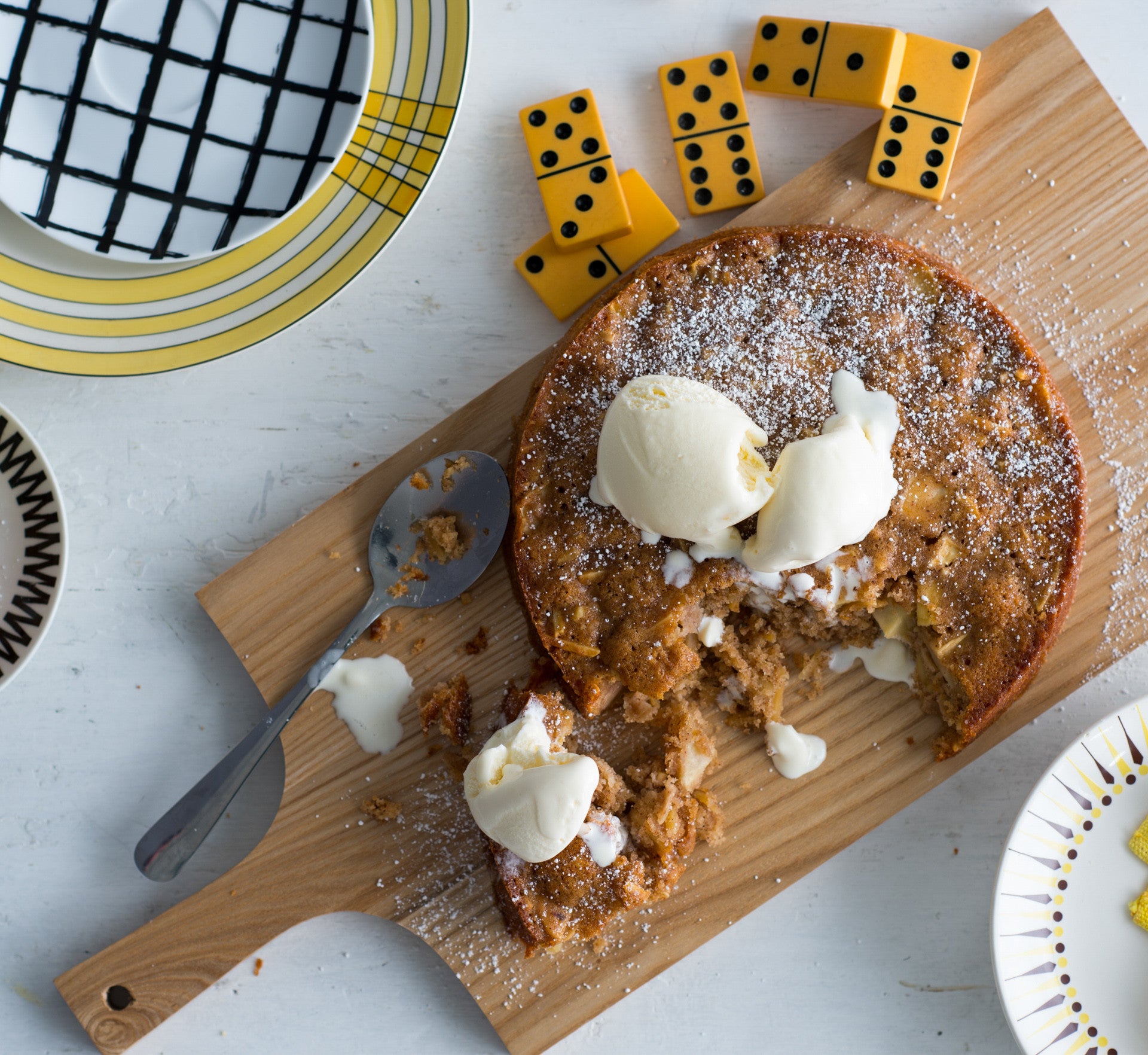
Prep 20minBake 35minMakes 8-10 serves
Much more like a cake than a pie, this apple-dense traditional Norwegian dessert is comforting, homely and can warm the soul with just one mouthful – especially when served straight from the oven in generous scoops and topped with ice-cream or a large dollop of thick cream. Don’t overlook the fact that it is also pretty good served like any other cake, cooled and in wedges. The trick to this recipe is not to over-mix – only mix until the wet and dry ingredients are evenly combined.
Ingredients
- Melted butter, to grease
- 110g (¾ cup) plain flour
- 1 teaspoon baking powder
- 1 teaspoon ground cinnamon
- ½ teaspoon ground cardamom
- 110g (½ cup) caster sugar
- 3 medium (about 150g each) apples (such as golden delicious, royal gala or pink lady), peeled, cored and cut into 2 cm pieces
- 80g slivered almonds, toasted
- 100g butter, melted and cooled
- 1 egg
- 2 tablespoons milk
- 1½ teaspoons natural vanilla essence or extract
- Vanilla ice-cream or thick cream, to serve
Method
- Preheat the oven to 180°C (160°C fan-forced). Grease a 20cm springform tin with melted butter and line the base with baking paper.
- Sift together the flour, baking powder, cinnamon and cardamom into a large bowl. Stir in the sugar, apple and almonds. Use a fork to whisk together the butter, egg, milk and vanilla. Add to the flour mixture and use a spatula to mix until just combined.
- Spoon the mixture into the prepared tin and spread evenly with the back of a spoon. Bake in the preheated oven for 35 minutes or until golden and a skewer inserted into the centre comes out clean.
- Stand the pie in the tin for 5–10 minutes before removing the sides of the tin. Serve warm in scoops or at room temperature in wedges with ice-cream or cream.
Baker's Tips
- This pudding/cake will keep in an airtight container at room temperaturein a cool spot for up to 3 days.
This recipe is from Anneka's SBS Food online column, Bakeproof: Scandi Baking. CLICK HERE for more Bakeproof recipes.
Photography by Alan Benson.
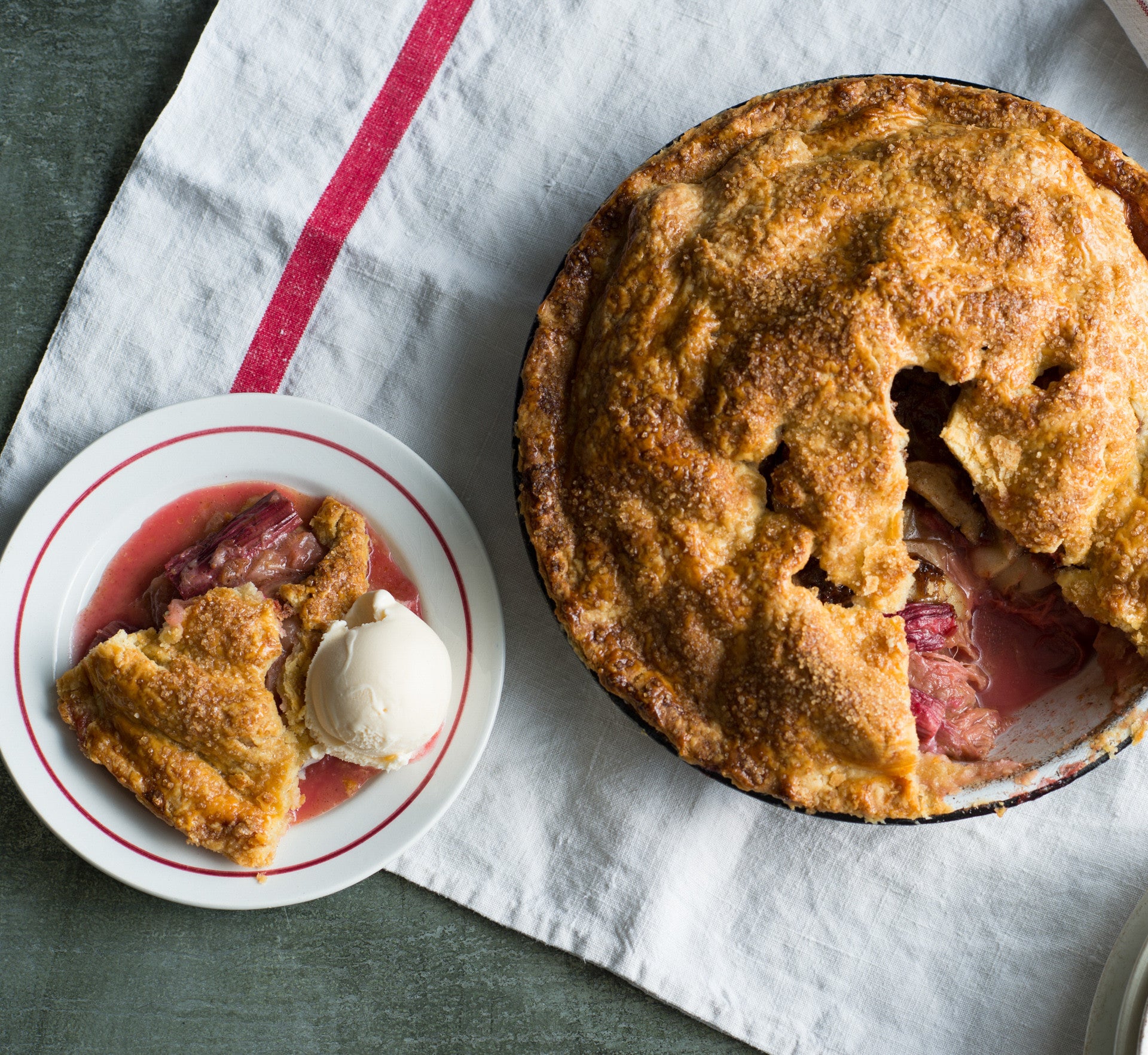
Prep 30min (+35min pastry making time)Bake 1hr 15minMakes 8-10 serves
Classic apple pie (served with a overly-generous scoop of vanilla ice-cream, of course) is one of the perennial delights of winter and can only be improved by the addition of rhubarb and a deliciously rich vanilla sour cream pastry. This pie just may be a little hard to beat.
Ingredients
1 egg, whisked, for brushing1 quantity vanilla sour cream pastry, shaped into a disc before wrapping and chilling as directed
2 teaspoons demerara sugar, to sprinkle
pouring cream, vanilla ice-cream or custard, to serve
Apple and rhubarb filling
1 teaspoon ground cinnamon1 teaspoon vanilla bean paste
1 orange, rind finely grated
110g (½ cup) demerara sugar
1½ tablespoons plain flour
1kg (about 6 medium) Granny Smith apples
750g trimmed rhubarb, cut into 4 cm lengths (see Baker’s Tips)
30g unsalted butter, finely diced
Method
- Preheat the oven to 200°C (180°C fan-forced).
- To make the apple and rhubarb filling, use your fingertips to rub the cinnamon, vanilla bean paste and orange rind through the sugar in a medium bowl. Stir in the flour. Peel, core and cut the apples into thin (about 3 mm) slices and place in a separate large bowl, along with the rhubarb and the sugar mixture. Use your hands to toss gently to combine evenly.
- Spoon the apple and rhubarb filling into an ungreased 23cm diameter (top measurement) ceramic or metal pie dish (see Baker’s Tips) and then dot with the diced butter. Brush the edge of the pie dish with the whisked egg.
- Roll out the vanilla sour cream pastry to make a pie lid about 5 mm thick. Use a 2cm round cutter to cut out a circle form the centre of the pastry. Carefully drape the pastry loosely around the rolling pin and place on top of the pie. Use your thumb and index finger to press the pie pastry top onto the rim of the pie dish to seal. Use a small sharp knife to trim the excess pastry from around the edge. Brush the top of the pie with some of the remaining whisked egg and then sprinkle with demerara sugar.
- Bake for 30 minutes. Reduce the oven temperature to 160°C (140°C fan-forced) and bake for a further 40-45 minutes or until the pastry is golden and cooked through and the apples are tender (see Baker’s Tips). Remove the pie from the oven and stand for 5 minutes before serving warm with cream, ice cream or custard.
Baker's Tips
- For this recipe you will need a ceramic pie dish measuring 23cm across the top, 17cm across the base and 7cm deep.
- You will need about 1kg untrimmed rhubarb for this recipe.
- To check if the apples are tender, insert a skewer into the centre of the pie.
This recipe is from Anneka's SBS Food online column, Bakeproof: Pies.
CLICK HERE for more Bakeproof recipes.
Photography by Alan Benson.
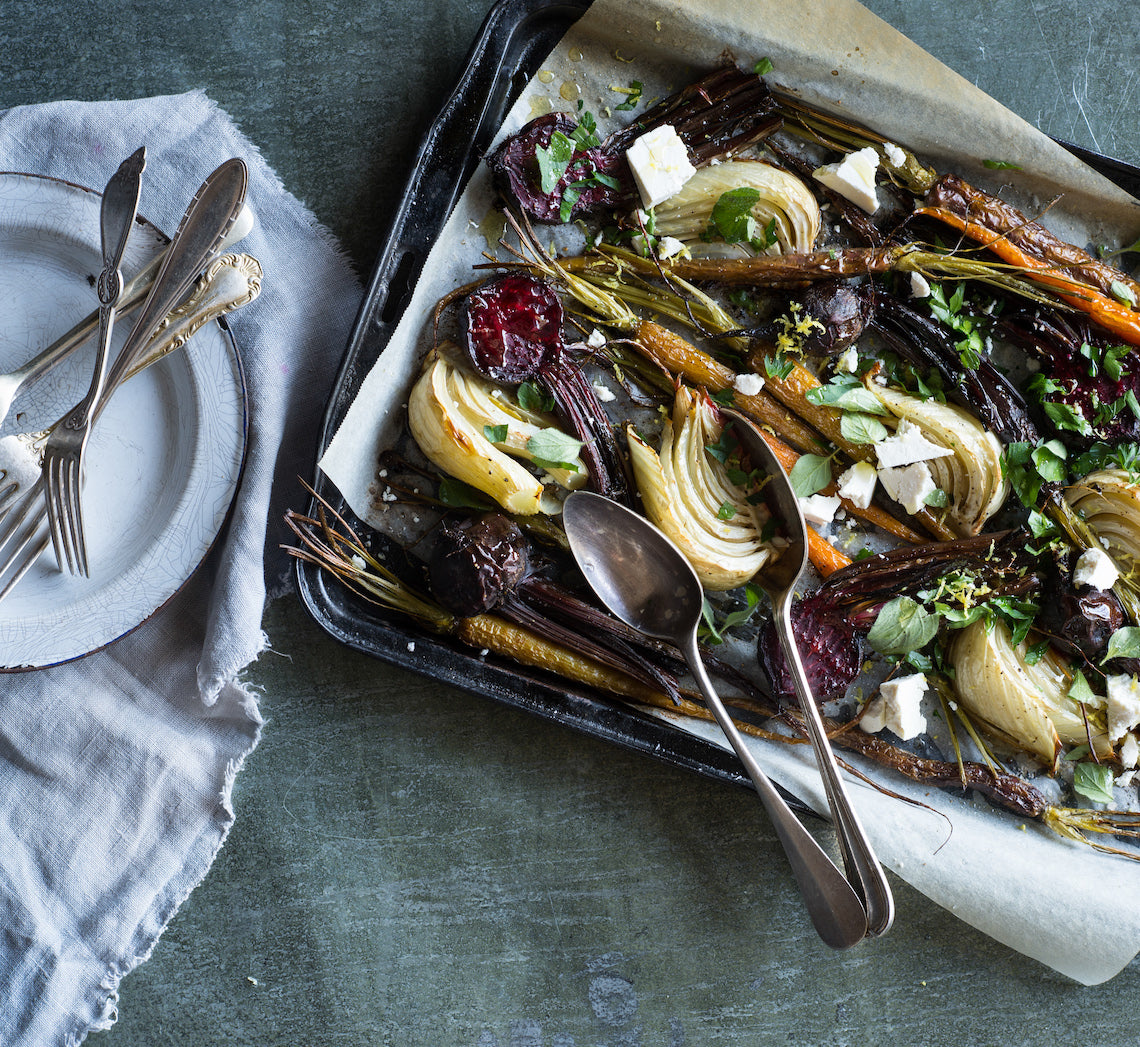
Prep 15minBake 40minMakes 6 serves
The simplicity of these roasted winter root vegetables allows their true flavours to shine – especially when finished with fresh herbs, lemon and ricotta salata.
Ingredients
- 1 bunch baby beetroot, scrubbed, trimmed and halved if large
- 1 bunch baby (Dutch) carrots, scrubbed, trimmed and halved
- 1 fennel bulb, trimmed and cut into 8 wedges
- 3 small parsnips, scrubbed, trimmed and quartered
- 2 tablespoons extra-virgin olive oil, plus extra to drizzle
- 40g ricotta salata (see Baker's Tips) or sheep's milk feta, crumbled or coarsely grated
- 1½ tablespoons oregano leaves
- 1½ tablespoons chopped flat-leaf parsley
- 1 lemon, zest finely grated
- lemon wedges or cheeks, to serve
Method
- Preheat the oven to 220°C (200°C fan-forced)
- Toss the beetroot, carrots, fennel and parsnip with the oil to coat. Spread over the base of a roasting dish and bake for 40 minutes, tossing once halfway through baking, or until the beetroot is tender when pierced with a skewer.
- Remove the vegetables from the oven and transfer to a serving platter. Drizzle with a little more oil. Combine the ricotta salata, oregano, parsley and lemon zest and scatter over the vegetables. Serve warm or at room temperature with lemon wedges.
Baker's Tips
- Ricotta salata is an Italian ricotta cheese that has been pressed, salted and aged for at least 90 days. It has a wonderfully salty flavour and firm texture which is perfect for crumbling, slicing or grating.
This recipe is from Anneka's SBS Food online column, Bakeproof: Winter Root Vegetables. CLICK HERE for more Bakeproof recipes.
Photography by Alan Benson.
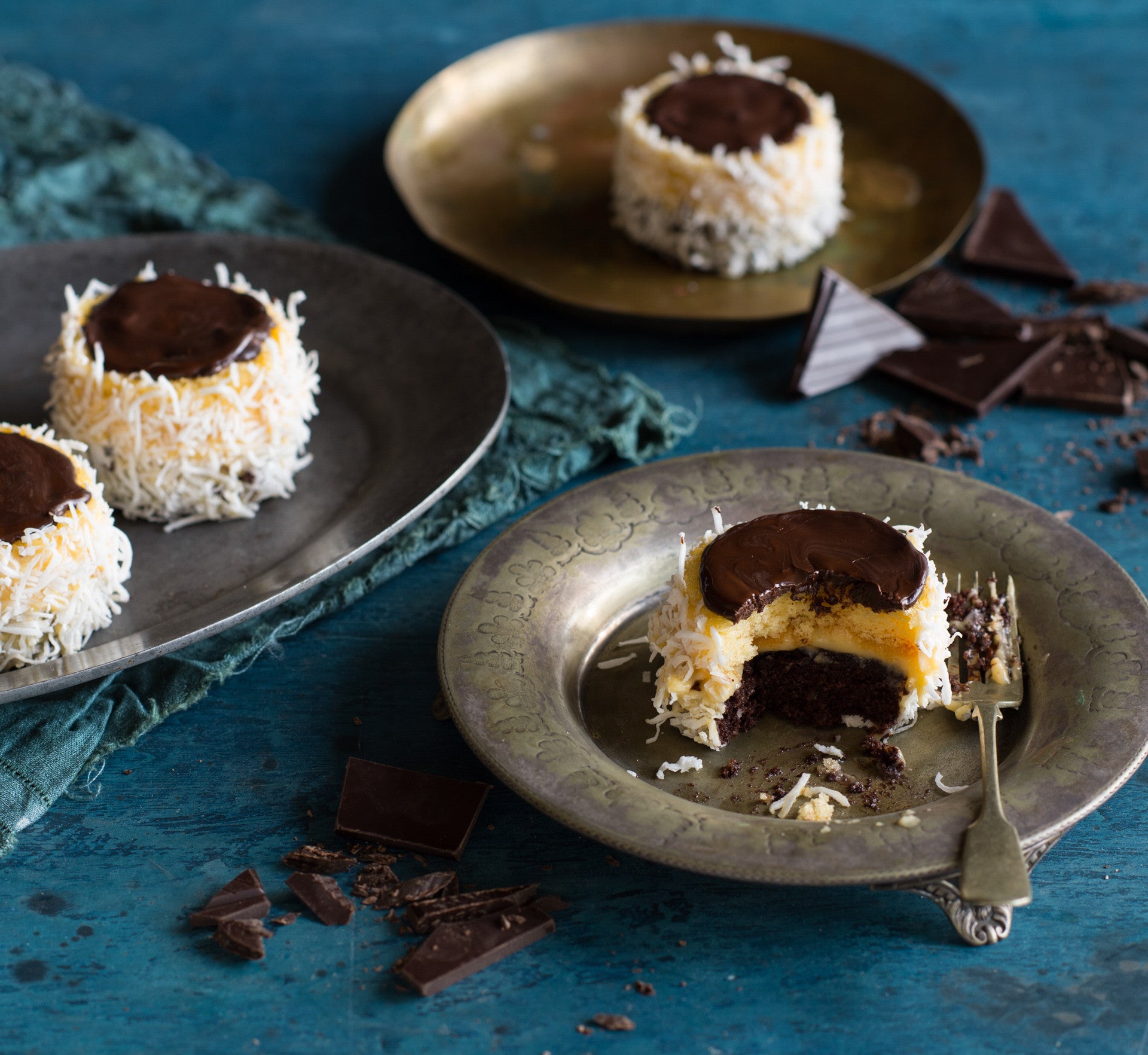
Prep 40min (+20min cooling and 2.5hr chilling)Bake 15minMakes 6 serves
These little layered cakes are the sweetest hats you'll find. Made up of custard cream and a chocolate topping they are covered in shredded coconut for a little texture but you can also use nuts as well, if you have them handy. They are best served chilled and if you aren't much for a dessert fork, then eating these with your hands like a cupcake is absolutely acceptable!
Ingredients
- 100g (1½ cups) shredded coconut, to coat
Sponge Layers
- melted butter, to grease
- 4 eggs, at room temperature
- 165g (¾ cup) caster sugar
- 2 tablespoons boiling water
- 2 tablespoons vegetable oil
- 100g (⅔ cup) self-raising flour, sifted
- 2 tablespoons cocoa powder mixed to a paste with 60 ml (¼ cup) boiling water and cooled
Custard cream
- 1 tablespoon cornflour
- 1 tablespoon custard powder
- 2 tablespoons caster sugar
- 200ml milk
- 20g butter, cubed
- 1 egg yolk
- 1½ teaspoons natural vanilla essence or extract
Chocolate glaze
- 50g dark chocolate, chopped
- 2 teaspoons vegetable oil
Method
- To make the custard cream, sift together the cornflour and custard powder into a small saucepan. Add the sugar and then use a balloon whisk to gradually stir in the milk. Place the saucepan over a medium heat and cook, stirring frequently, until the mixture boils and thickens. Remove from the heat and stir in the butter, egg yolk and vanilla until well combined. Pour into a medium bowl, cover the surface of the custard directly with a piece of plastic wrap and set aside to cool (this will take about 2 hours).
- To make the sponge layers, preheat oven to 180°C (160°C fan-forced). Brush two 16 x 26 cm shallow cake tins with a little melted butter to lightly grease and then line the base and two long sides of each with one piece of non-stick baking paper.
- Use an electric mixer with a whisk attachment on high speed to whisk the eggs and sugar in a large bowl until the mixture is very thick and pale (this will take 5-8 minutes). Lift the whisk out of the mixture and draw a figure eight, if the trail stays on the surface long enough for you to finish drawing then the mixture is ready. If not, continue to whisk for a further minutes and then test again.
- Combine the boiling water and oil. Sift the flour over the egg mixture. Immediately pour the warm water and oil mixture down the side of the bowl and use a spatula to fold until just evenly combined (be careful not to overmix).
- Pour half of the mixture into one of the prepared cake tins. Add the cocoa paste to the mixture still in the bowl and fold together until just combined. Pour into the second cake tin. Gently tap the tins on the bench top three times to settle the mixture. Bake in preheated oven for 12-15 minutes or until the cakes spring back when lightly touched in the centre and start pulling away from the sides of the tins. Stand the cakes in the tins for 2 minutes before turning onto a wire racks to cool completely.
- To assemble, use a 6 cm round cutter to cut each of the Sponge cakes into 6 rounds. Place the round cutter over a chocolate sponge. Top the chocolate sponge round with about 1 tbsp of the Custard cream and then cover with around of plain sponge. Remove the pastry cutter. Repeat with the remaining chocolate and plain sponge rounds and 1 tbsp of Custard cream for each cake to make 6 layered cakes in total. Spread the sides of the cakes with the remaining Custard cream. Roll the sides of the cakes in the coconut to coat and place on a serving plate. Place in the fridge while making the Chocolate glaze.
- Place the chocolate and oil in a heatproof bowl. Place over a saucepan of simmering water, stirring occasionally, until melted and smooth. Carefully spread about 1 tsp of the Chocolate glaze over the tops of each of the cakes to cover. Return the cakes to the fridge for 30 minutes or until the Chocolate glaze is set. Serve chilled.
Baker's Tips
These cakes will keep in an airtight container in the fridge for up to 2 days.This recipe is from Anneka's SBS Food online column, Bakeproof: Bosnian Baking.
CLICK HERE for more Bakeproof recipes.
Photography by Alan Benson.
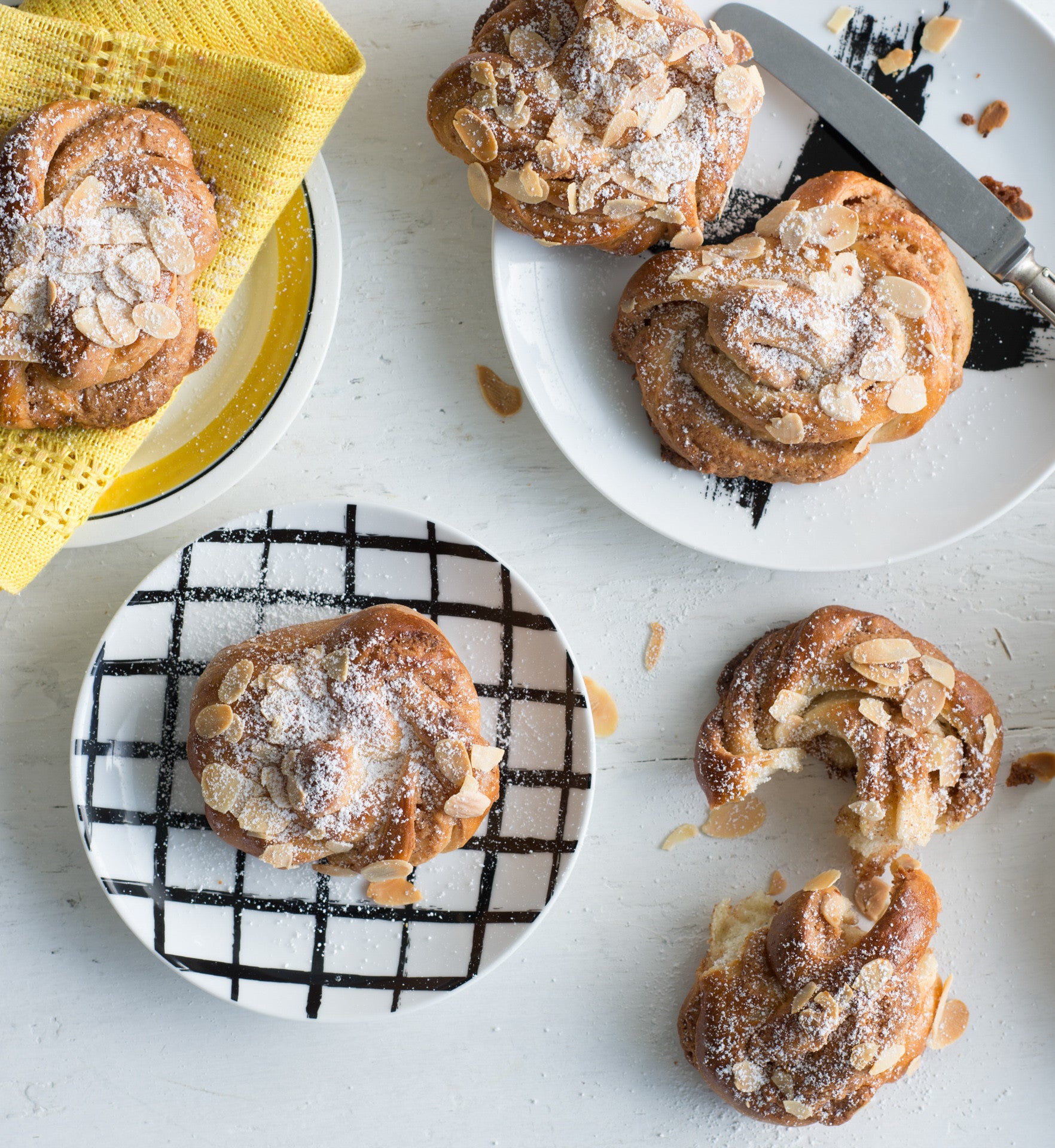
Prep 40min (+1hr 15min proving time)Bake 25minMakes about 16
The Swedes love their sweet buns so much they have even declared 4 October National Cinnamon Bun Day! These more-ish cinnamon-almond filled buns are the quintessential accompaniment to a fika (or coffee). The traditional twisting and shaping of them may seem a little tricky to start with but follow my instructions and watch this quick video and you’ll have it mastered in no time.
Ingredients
melted butter, to grease1 egg, lightly whisked, to glaze
flaked almonds or pearl sugar (see Baker's Tips), to sprinkle
Dough
450g (3 cups) strong bread or pizza flour, plus extra to dust55g (¼ cup) caster sugar
7g (1 sachet) dried yeast
1 teaspoon ground cardamom
½ teaspoon salt
300ml milk
100g butter, diced
1 teaspoon natural vanilla essence or extract
Almond filling
80g butter, at room temperature50g (½ cup) almond meal
50g marzipan
55g (¼ cup) caster sugar
1½ teaspoon ground cinnamon
Method
- To make the dough, combine the flour, sugar, yeast, cardamom and salt in a large bowl and make a well in the centre. Combine the milk and butter in a small saucepan and heat over low heat for 3–5 minutes or until the milk is lukewarm. Remove from heat, stir in the vanilla and set aside for 5 minutes, stirring occasionally with a fork, until the butter melts. Add to the flour mixture and use a wooden spoon and then your hands to mix to a soft dough.
- Turn the dough onto a lightly floured surface and knead for 8–10 minutes or until it is smooth and elastic and springs back when you push your finger into it (see Baker's Tips).
- Brush a large bowl with melted butter to grease. Add the dough turning it to coat lightly with the butter. Cover with plastic wrap and place in a warm, draught-free place for 1 hour or until doubled in size. (See Baker's Tips).
- To make the almond filling, place all the ingredients in a food processor and process until smooth and well combined, scraping down the side of the bowl when necessary. Set aside.
- Line two large baking trays with baking paper.
- When the dough has doubled in size knock it back by punching it in the centre with your fist. Turn onto a lightly floured surface and knead for 2–3 minutes or until smooth and elastic. Use a lightly floured rolling pin to roll out the dough into a 30 cm x 50 cm rectangle, about 0.5cm thick. Place the dough on the benchtop so that a long side is closest to you.
- Use a palette knife to spread the almond filling evenly over the lower half of the dough. Fold the top third down to cover the filling and then the bottom third up, pressing down firmly.
- Use a large, sharp knife to cut the dough into 16 strips, each about 3.5cm wide. Use the knife to cut each strip in half three-quarters of the way up towards the folded end to make two 'legs'. Hold a strip at opposite ends and pull gently to stretch slightly. Then twist the two 'legs' separately about three times. Tie the two 'legs' together in a simple knot and then tuck the opposite end under the knot.
- Repeat with the remaining dough strips, placing them about 5cm apart on the lined trays as they are shaped. Cover with a damp tea towel and set aside in a warm, draught-free place for 25–30 minutes or until risen and the dough no longer springs back when you poke it gently with a finger.
- Preheat the oven to 190°C (170°C fan-forced).
- Brush the rolls with the whisked egg to glaze and sprinkle with flaked almonds or pearl sugar. Bake the rolls in preheated oven for 25 minutes or until golden and sound hollow when tapped on the base. Serve warm or at room temperature.
Baker's Tips
- Pearl sugar (also known as hail or nib sugar) is a coarse white sugar used extensively in European baking. Because it retains its shape (it doesn’t melt during cooking) it adds a lovely textural sweet crunch to pastries, sweet breads and biscuits. Pearl sugar is available at specialty food stores and European-style delicatessens.
- The dough can be kneaded with an electric mixer, fitted with a dough hook, on low speed for 5–8 minutes or until smooth and elastic and comes away from the side of the bowl.
- The dough can be proved in the fridge overnight (in the greased, covered bowl). Stand in a warm, draught-free place for 1–2 hours, or until the dough reaches room temperature, before continuing with the recipe.
- These rolls are best eaten the day they are baked, however they do freeze well. To freeze, wrap individually in plastic wrap, seal them in an airtight container or freezer bag and freeze for up to 3 months. Thaw at room temperature. To reheat, place on a lined baking tray in an oven preheated to 160°C (140°C fan-forced) for 10 minutes or until heated through.
This recipe is from Anneka's SBS Food online column, Bakeproof: Scandi Baking.
CLICK HERE for more Bakeproof recipes.
Photography by Alan Benson.

Prep 30min (+40min proving)
Bake 15minMakes 4serves
Similar to Indian Naan, just lighter and flakier (and in my opinion yummier), taftan is a hearth-baked flatbread from Persia and Pakistan. It is often flavoured with saffron – as this one is – which gives it a striking golden hue and alluring flavour perfect to serve alongside curries and soups (although don’t discount just nibbling it on its own).
Ingredients
- 260g (1¾ cups) bread or pizza flour
- 2 teaspoons sugar
- 1 teaspoon salt
- ½ teaspoon instant dried yeast
- 70g (3½ tbsp) ghee, melted
- 2 tablespoon Greek-style natural yoghurt
- 80ml (⅓ cup) milk
- 1 tablespoon vegetable oil, plus extra to grease
- 2 teaspoons nigella seeds
- 1 good pinch saffron, soaked in 1 tbsp hot water
Method
- Combine the flour, sugar, salt and yeast in a large bowl and make a well in the centre. Combine the milk, yoghurt and 40g (2 tablespoons) of the melted ghee, add to the dry ingredients and use a wooden spoon and then your hands to mix to a soft dough. Turn onto a lightly floured bench top and knead for 8-10 minutes or until smooth and elastic and springs back when you push your finger into it.
- Brush a medium bowl with extra oil to grease, add the dough and turn to coat. Cover with plastic wrap and set aside in a warm, draught-free place for 40 minutes or until risen slightly.
- Preheat the oven to 200°C (180°C fan-forced). Line two large heavy baking trays with baking paper.
- Knock back the dough by punching it in the centre with your fist. Turn onto a lightly floured bench top and knead for 2-3 minutes or until smooth and elastic and the dough has returned to its original size. Divide the dough evenly into 2 portions and brush each with the oil to coat.
- Use a rolling pin to roll out a portion into a rough circle about 22cm in diameter and 5mm thick. Then use your hands to pull one end to shape into a teardrop, about 17cm x 24cm, pressing the centre to create a thicker edge. Transfer to a baking tray and then use your fingertips to make indents all over the surface of the flatbread. Repeat with the remaining dough portion. Brush the flatbreads with the saffron liquid and then sprinkle with the nigella.
- Bake for 10 minutes. Brush the surface of the flatbreads with the remaining melted ghee. Swap the trays around and then bake for a further 5-10 minutes or until the flatbreads are golden and cooked through.
- Serve warm or at room temperature along side a soup or curry.
Baker's Tips
This flatbread will keep in an airtight container at room temperature for up to 2 days but it is best eaten the day it is baked.This recipe is from Anneka's SBS Food online column, Bakeproof: Yeast-leavened Flatbreads.
CLICK HERE for more Bakeproof recipes.
Photography by Alan Benson.
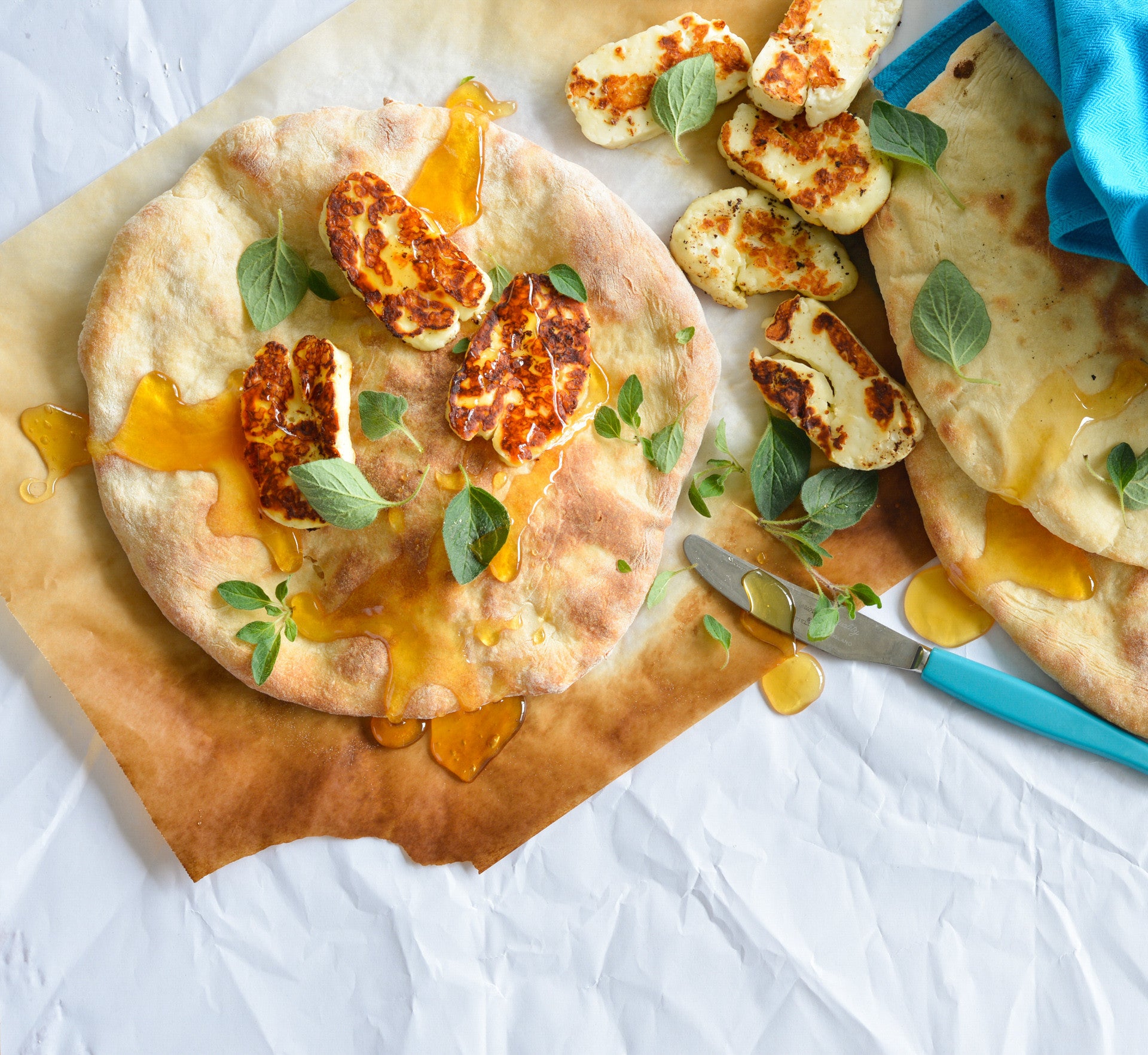
Prep 30min (+2hr proving)
Bake 40-50minMakes 4 serves
This mor-ish flatbread has a long fermentation time that gives its distinctive well-developed and slightly sour flavour. It’s perfect for dipping into and sopping up fragrant Middle Eastern stews and dips.
Ingredients
- 600 g (4 cups) plain flour
- 1 sachet (7 g) instant dried yeast
- 2 tsp sugar
- 1½ tsp salt
- 375 ml (1½ cups) warm water
- 130 g (½ cup) Greek-style natural yoghurt, at room temperature
- 1 tbsp olive oil
- Honey, good-quality pan-fried or grilled haloumi and fresh oregano leaves, to serve
Method
- Combine the flour, yeast, sugar and salt in a large bowl. Combine the water, yoghurt and oil, add to the flour mixture and use a wooden spoon and then your hands to mix to a soft dough (the dough will be quite sticky at this stage). Cover the bowl with a damp tea towel and set aside in a warm, draught-free place for 2-3 hours or until well risen.
- Place a pizza stone in the oven on the centre and preheat to 250°C (230°C fan-forced).
- Divide the dough into 4 portions. Use your hands to flatten each portion into a round on a floured bench top to about 26 cm in diameter and 6-7 mm thick. Place on a piece of baking paper on a tray and cover with a damp tea towel. Set aside in a warm, draft-free place for 15 minutes to rise slightly. Repeat with the remaining 3 dough portions.
- Use the baking paper to lift a bread round onto the pizza stone in the oven and bake for 10-13 minutes or until golden and baked though. Remove from the oven and wrap in a clean tea towel to keep warm while baking the remaining flatbreads in the same way (the flatbread will be crusty on the outside to start with and then will soften as it stands wrapped in the tea towel).
- Serve warm topped with honey, haloumi and oregano leaves.
Baker's Tips
You can also bake these flatbreads on baking paper-lined oven trays for 15 minutes.These flatbreads are best eaten the day they are baked.
This recipe is from Anneka's SBS Food online column, Bakeproof: Yeast-leavened Flatbreads.
CLICK HERE for more Bakeproof recipes.
Photography by Alan Benson.

Prep 20min (+ cooling time)Bake 25-30minMakes 12
Based on a cake I have made for years as a wedding cake for friends, this recipe is incredibly simple but still has a wonderful celebratory feel. It also makes truly divine individual cakes like these sweet butterfly cakes.
Ingredients
Melted butter, to grease (optional)
200g (7oz) good-quality white chocolate, chopped
150g (5¼oz) unsalted butter, cubed
185ml (¾ cup/6½fl oz) water
220g (1 cup/7¾) caster sugar
2 eggs, at room temperature, lightly whisked
1½ teaspoons natural vanilla extract or essence
225g (1½ cup/8oz) plain flour
50g (½ cup/1¾oz) almond meal
1½ teaspoons baking powder
125ml (½ cup/4fl oz) thick (double) cream
165g (½ cup/5¾oz) raspberry or blackberry jam
Icing sugar, to dust
Method
- Preheat oven to 180°C/350°F (160°C/315°F fan-forced). Grease a 12-hole 80ml (⅓ cup/2½fl oz) capacity muffin tray with melted butter or line with paper cases.
- Put the chocolate, butter and water in a medium saucepan and stir over medium heat just until the chocolate and butter have melted and the mixture is smooth. Remove from the heat and set aside until cooled to room temperature.
- Add the sugar, eggs and vanilla to the chocolate mixture and use a balloon whisk to stir until well combined.
- In a medium bowl, use a clean whisk or fork to whisk together the flour, almond meal and baking powder, combining the ingredients evenly and breaking up any lumps of almond meal. Add to the chocolate mixture and stir with the whisk until just combined.
- Divide the mixture evenly among the muffin holes and lightly tap the tin on the bench top to remove any large air bubbles. Bake in the preheated oven for 25–30 minutes or until a skewer inserted in the centre of a cake comes out clean. Leave the cakes to stand in the tin for 5 minutes before turning out onto a wire rack to cool completely.
- When cool, cut a shallow cone-shaped piece out of the top of a cake, leaving about a 1cm/½in border. Cut the piece of cake in half. Spoon a little cream and then some jam into the hole to fill. Arrange the two pieces of cake in the jam to form wings. Repeat with the remaining cakes, cream and jam. Dust with icing sugar to serve.
Baker's Tips
- The unfilled cakes will keep in an airtight container at room temperature in a cool spot for up to 2 days. Alternatively they will freeze well sealed in a freezer bag or airtight container for up to 1 month. Thaw at room temperature.
- These cakes are best eaten the day they are filled.
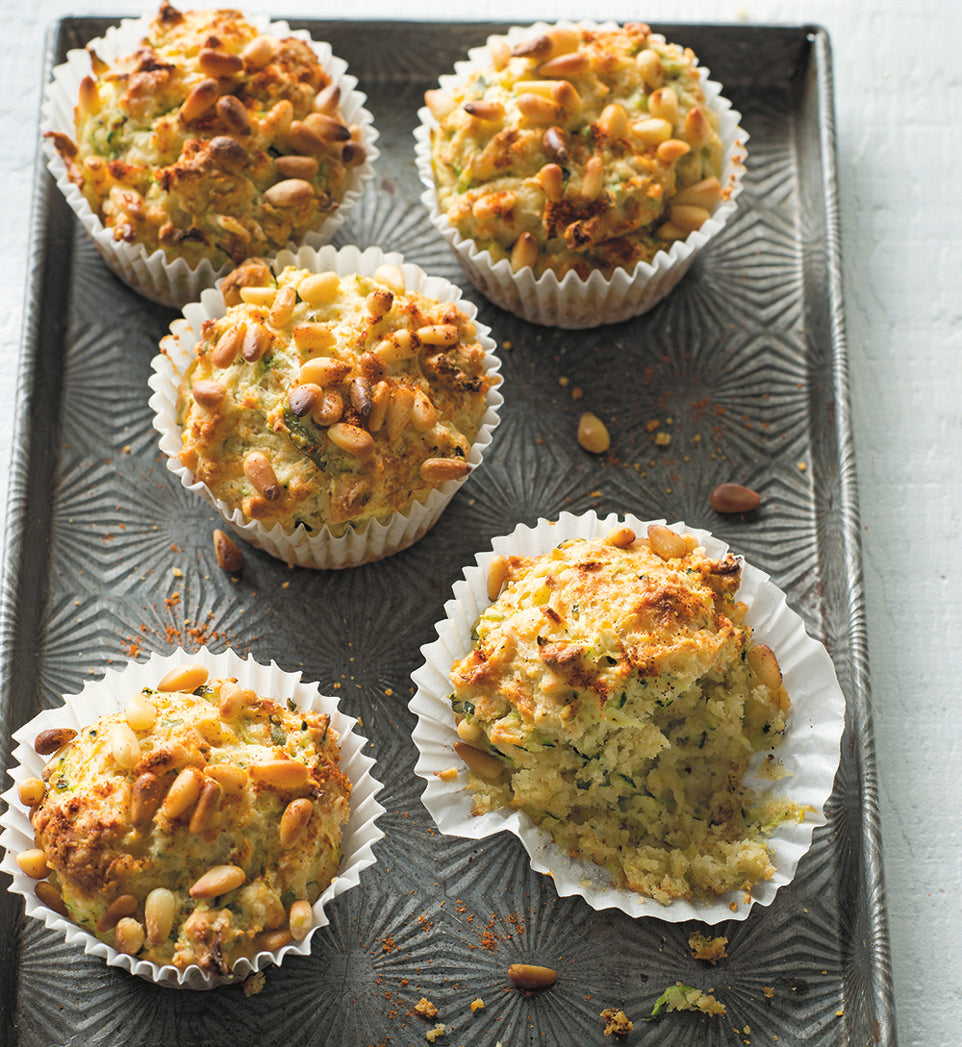
Prep 15min (+ 5min standing time)Bake 25min-30minMakes about 12
Savoury muffins are a great alternative to the sweet ones, especially when served as a snack or instead of bread alongside soup or salad. The zucchini in these makes them lovely and moist while adding substance.
Ingredients
Light olive oil or sunflower oil, to grease (optional)
150g (1 cup) plain flour
150g (1 cup) wholemeal plain flour
1 tablespoon baking powder
½ teaspoon salt
70g (⅔ cup) finely grated parmesan cheese
65g (⅔ cup) coarsely grated vintage cheddar cheese
¼ cup chopped basil leaves
185ml (¾ cup) buttermilk
80ml (⅓ cup) light olive oil or sunflower oil
2 eggs, at room temperature
2 zucchini (about 100g each) ends trimmed, coarsely grated
40g (¼ cup) pine nuts, to scatter
Cayenne pepper, to sprinkle
Method
- Preheat the oven to 190°C (170°C fan-forced). Line a 12-hole 80ml (⅓ cup) capacity muffin tin with paper cases or grease with a little vegetable oil.
- Sift together the flours, baking powder and salt into a large bowl, returning any husks left in the sieve to the bowl. Season well with pepper and then gently stir in the parmesan, cheddar and basil. Make a well in the centre.
- Use a fork to whisk together the buttermilk, olive oil and eggs in a bowl. Add the zucchini and mix to combine. Add to the flour mixture and use a spatula or large metal spoon to fold together until just combined. (Don’t overmix – the batter should still be a little lumpy.)
- Spoon the mixture into the prepared muffin holes, dividing evenly. Scatter over the pine nuts and sprinkle with a little cayenne pepper. Bake in the preheated oven for 25–30 minutes or until the muffins are golden and a skewer inserted in the centre comes out clean. Leave to cool in the tin for 5 minutes before transferring to a wire rack. Serve warm or at room temperature.
Baker's Tips
- These muffins are best eaten the day they are baked, however they freeze well – wrap individually in plastic wrap and then seal in an airtight container or freezer bag. Freeze for up to 3 months. Thaw at room temperature.
Photography by Alan Benson.
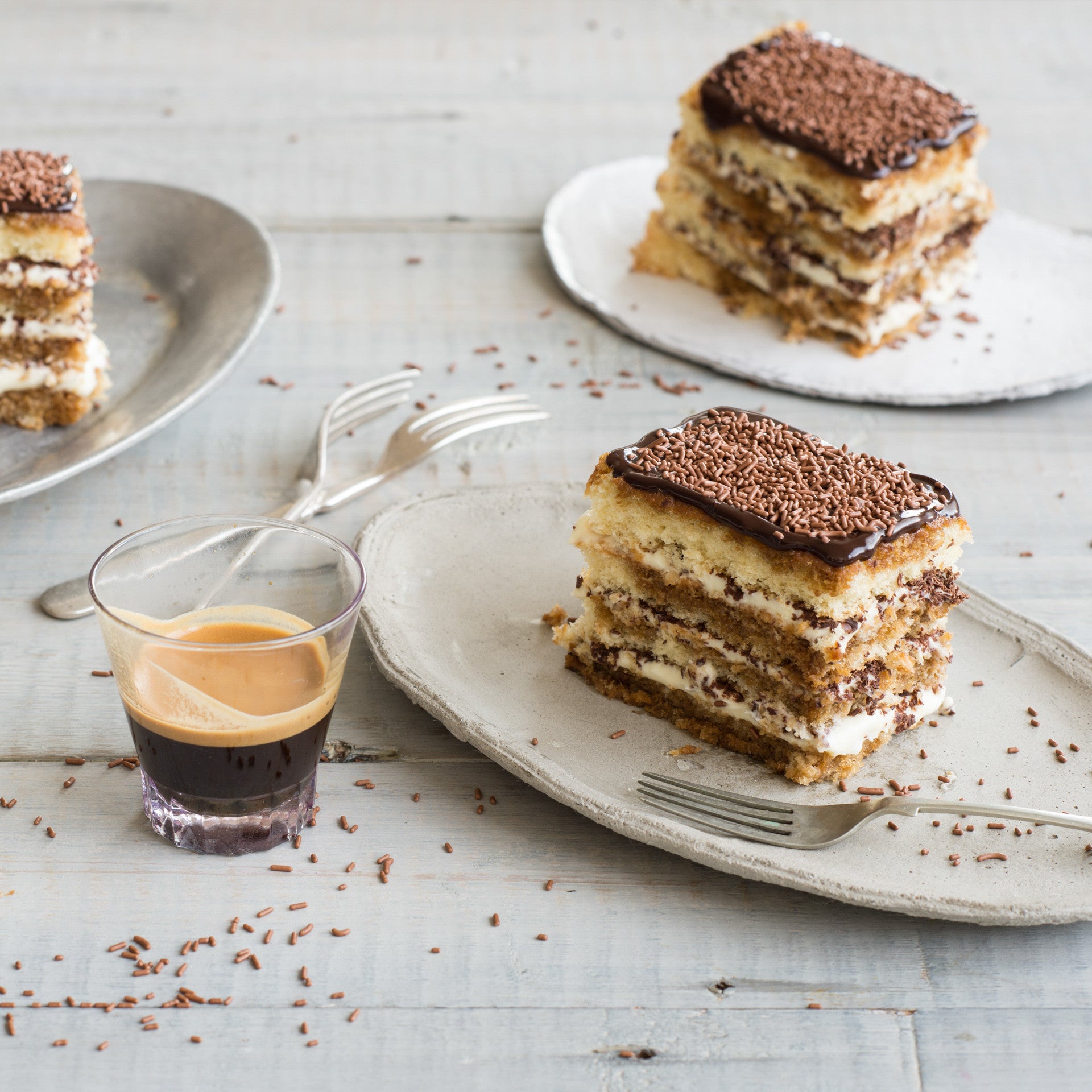
Prep 40min (+2hr 30min chilling and 20min cooling time)Bake 15minMakes 8 serves
This Italian classic is taken to a whole new level as elegant individual dessert cakes with a rich chocolate topping... Just serve with a fork!
Ingredients
185ml (¾ cup) strong freshly brewed coffee60ml (¼ cup) Marsala
75g good-quality dark chocolate (70% cocoa), grated
Chocolate dollar fives, to sprinkle (optional)
Sponge Layers
Melted butter, to grease4 eggs, at room temperature
165g (¾ cup) caster sugar
60ml (¼ cup) milk
20g butter
110g (¾ cup) self-raising flour, plus extra to dust
30g (¼ cup) cornflour
Mascarpone mixture
150ml thickened cream90g (⅔ cup) icing sugar, sifted
125g mascarpone
Chocolate ganache
250g good-quality dark chocolate (54% cocoa), chopped80ml (⅓ cup) pouring cream
Method
- To make the Sponge Layers, place the oven rack in the lower third of the oven and then preheat it to 180°C (160°C fan-forced). Brush two 30cm x 20cm shallow cake tin with a little melted butter to lightly grease and hen line the base and sides with one piece of baking paper, cutting into the corners to fit.
- Use an electric mixer with a whisk attachment on high speed to whisk the eggs and sugar in a large bowl until until the mixture is very thick and pale (this will take about 5 minutes). Lift the whisk out of the mixture and draw a figure eight, if the trail stays on the surface long enough for you to finish drawing then the mixture is ready. If not, continue to whisk for a further minutes and then test again.
- Heat the milk and butter in a small saucepan over medium heat just until the butter melts. Remove from the heat. Sift the flour and cornflour together over the egg mixture. Immediately pour the warm milk mixture down the side of the bowl and whisk again with the electric mixer briefly, until the flour mixture is just incorporated (be careful not to over mix).
- Divide the mixture evenly between the prepared tins, and use a spatula or the back of a spoon to spread evenly. Gently tap the tins on the bench top three times to settle the mixture. Bake in preheated oven for 12-14 minutes or until the cake is a pale golden colour, spring back when lightly touched in the centre and start pulling away from the sides of the tin. Remove from the oven and stand for 2 minutes before turning onto a wire rack to cool completely (this will take about 20 minutes).
- Line the base and sides of a 16cm x 26cm cake tin with two strips of non-stick baking paper allowing the paper to overhand the sides by about 10cm.
- To make the mascarpone mixture, use an electric mixer with a whisk attachment to whisk the cream and icing sugar on medium speed until soft peaks form. Add the mascarpone and whisk until firm peaks just form.
- Cut each of the sponge in half. Combine the coffee and Marsala. Place one sponge layer on the base of the prepared tin and sprinkle with a quarter of the coffee mixture. Spread with a third of the Mascarpone mixture (about ½ cup) and then sprinkle with a third of the grated chocolate. Continue to layer with the remaining sponge, coffee mixture, grated chocolate and mascarpone mixture, finishing with a sponge layer sprinkled with the remaining coffee and Marsala mixture. Cover with plastic wrap and place in the fridge for at least 2 hours or until firm enough to cut.
- Use the overhanging baking paper to remove the tiramisu from the tin and transfer to a cutting board. Use a sharp knife trim the edges and then cut into 8 portions about 4.5cm x 7cm each and place on a wire rack over a tray. Return to the fridge while making the Chocolate ganache
- To make the Chocolate ganache, combine the chocolate and cream in a heatproof bowl and place over a saucepan of barely simmering water (make sure the base of the bowl doesn’t touch the water). Stir occasionally until just melted and combined.
- Remove the cakes from the fridge and place on a wire rack. Pour a little of the Chocolate ganache over each cake, spreading it to cover the top. Sprinkle with the chocolate Dollar Fives if using and return to the fridge for 30 minutes or until the ganache is set before serving.
Baker's Tips
- These Tiramisu cakes will keep in an airtight container in the fridge for up to 3 days.
This recipe is from Anneka's SBS Food online column, Bakeproof: Little Cakes. CLICK HERE for more Bakeproof recipes.
Photography by Alan Benson.

Prep 50min (+30min cooling and 30min standing time)Bake 25minMakes about 12
I debated about what to call these — a combination of the much-loved Arnott’s iced VoVo biscuits and the iconic lamington. Such a visual treat. I hope you love these fun little cakes as much as I do.
Ingredients
130g (2 cups) shredded coconut
48 fresh raspberries, halved lengthways, to decorate
Cakes
melted butter, to grease
105g (¾ cups) self-raising flour
75g (½ cup) plain flour
165g (¾ cup) caster sugar
125g butter, at room temperature
80ml (⅓ cup) milk
2 eggs, at room temperature
1 teaspoon natural vanilla extract or essence
1½ tablespoons raspberry jam
Raspberry frosting
2 egg whites
75g (⅓ cup) caster sugar
2 tablespoon raspberry jam, warmed and sieved
rose pink food colouring
Method
- Preheat the oven to 180°C (160°C fan-forced). Brush a 12 x 80ml (⅓ cup) rectangular friand or mini-loaf pan with melted butter to grease.
- Place the flour, sugar, butter, milk, eggs and vanilla in a large mixing bowl. Use an electric mixer to beat on low speed until combined. Increase the speed to medium and beat for 3 minutes or until the mixture is well combined and very pale in colour. Divide half the mixture among the friand pans and spoon the surface of each with the back of a teaspoon. Spoon ½ teaspoon of jam into the centre of each and then spoon the remaining cake batter over the top to cover, dividing evenly, and smoothing the surfaces carefully with the back of the spoon.
- Bake for 20-25 minutes or until the cakes are golden and cooked when tested with a skewer. Cool for 5 minutes in the pan, then transfer to a rack to cool completely (this will take about 30 minutes).
- To make the raspberry frosting, choose a medium heatproof mixing bowl that sits snugly on top of a medium saucepan. Quarter-fill the saucepan with water and bring to the boil. Reduce the heat to lowest possible setting. Put the egg whites and sugar in the heatproof bowl and place over the simmering water. Use a spatula to stir until the sugar dissolves. (You can tell if the mixture is ready by rubbing a little between your fingers — if it still feels grainy then continue to stir for another minute or until it no longer feels grainy.) Transfer the mixture to the bowl of an electric mixer and use a whisk attachment to whisk on high speed for 3-5 minutes or until very thick and glossy. Whisk in the jam until evenly combined. Add 2-3 drops, or enough to reach desired colour, of the food colouring to the meringue mixture and whisk until evenly combined.
- When the cakes are cool, spread the coconut on a tray. Spread the raspberry frosting over the top and sides of a cake and then dip the sides in the coconut to coat. Place on a serving plate and place 4 raspberry halves down the centre on top to decorate. Repeat with the remaining cakes, frosting, coconut and fresh raspberries. Set aside for 30 minutes for the frosting to firm slightly before serving.
Baker's Tips
- These cakes, without the fresh raspberries, will keep in an airtight container at room temperature for up to 2 days.
This recipe is from Anneka's SBS Food online column, Bakeproof: Aussie Day Favourites.
CLICK HERE for more Bakeproof recipes.
Photography by Alan Benson.
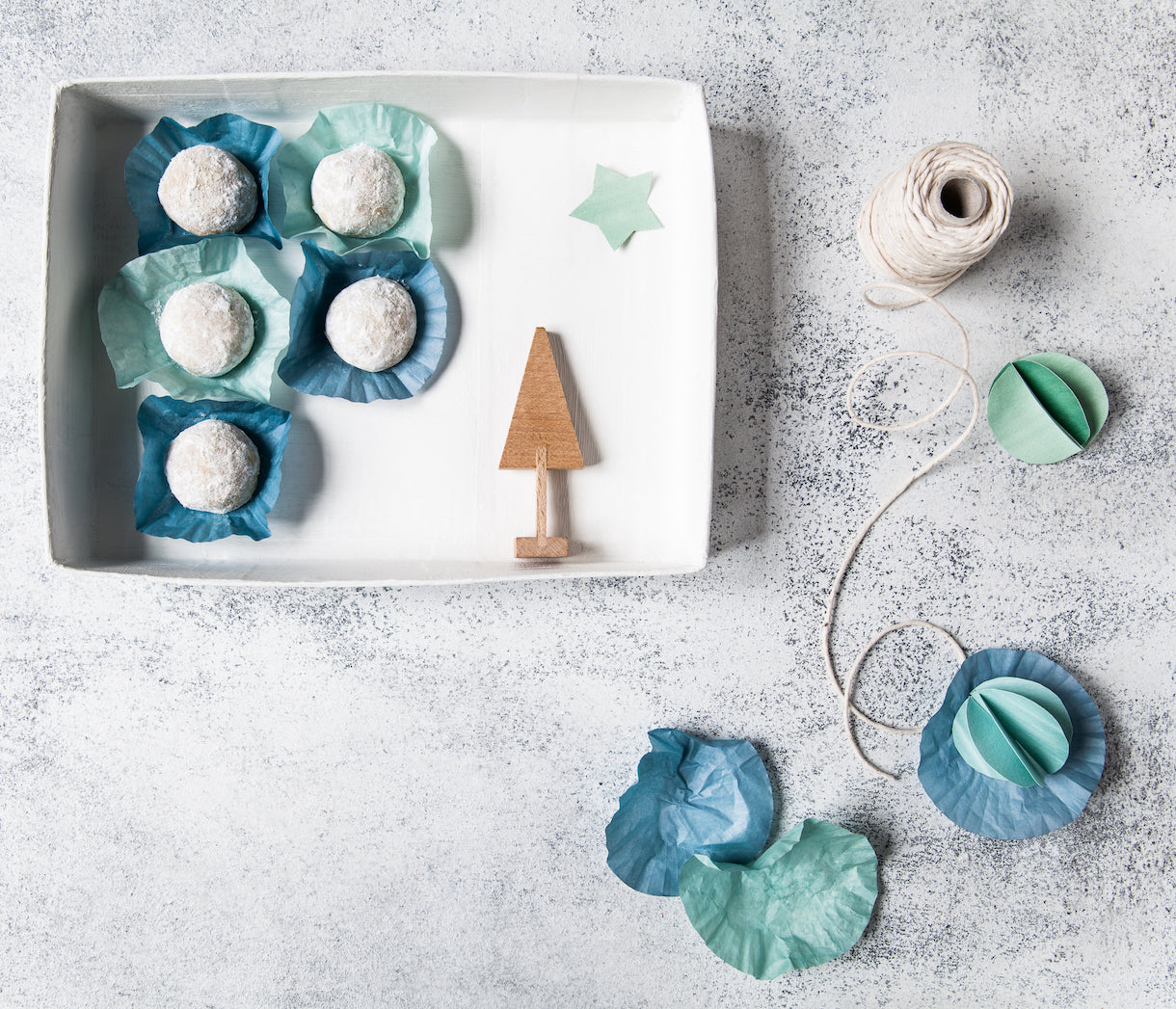
Prep 30min (+20min cooling time)Bake 15minMakes about 50
Often associated with Christmas in Germany, these bite-sized mouthfuls of gingerbread deliciousness actually originated in Scandinavia. The combination of a soft, highly spiced centre hidden beneath a crisp, sugar-powdered outer coat is pure, festive heaven.
Ingredients
125g (4½oz) unsalted butter, softened slightly
110g (½ cup, firmly packed/4oz) dark brown sugar
1 lemon, zest finely grated
1 orange, zest finely grated
90g (¼ cup/3oz) honey
1 egg, at room temperature
40g (¼ cup/1½oz) finely chopped candied citrus rind / mixed peel
350g (2⅓ cups/12¼oz) plain flour
½ teaspoon baking powder
½ teaspoon bicarbonate of soda
2 teaspoon ground cinnamon
½ teaspoon ground black pepper
½ teaspoon ground ginger
¼ teaspoon crushed aniseed
½ teaspoon ground nutmeg
¼ teaspoon ground cloves
¼ teaspoon ground allspice
125g (1 cup/4½oz) pure icing sugar, to dust
Method
- Preheat oven to 160°C/315°F (140°C/285°F fan-forced). Line two large oven trays with non-stick baking paper.
- Use an electric mixer with a paddle beater to beat the butter, sugar and citrus zest until just creamy. Add the honey and beat until just combined. Add the egg and beat until evenly combine. Mix in the candied citrus rind / mixed peel.
- Sift together the flour, baking powder, bicarbonate of soda and spices. Add the flour mixture to the butter mixture and beat on lowest possible speed until just combined and a soft dough forms.
- Roll heaped teaspoonfuls of the mixture into balls and place 5cm/2in apart on the lined trays. Bake in preheated oven for 10-12 minutes, swapping the trays halfway through baking, or until they start to crack and are just cooked through.
- Sift the icing sugar into a medium bowl. Add about 6 warm biscuits to the icing sugar and toss to coat generously. Place on a wire rack to cool and repeat with the remaining biscuits.
Baker's Tips
- The uncooked dough will keep covered in the fridge for up to 2 days. Roll and bake straight from the fridge.
- These biscuits will keep in an airtight container at room temperature for up to 1 month.
- Dust with icing sugar again just before serving if desired.






